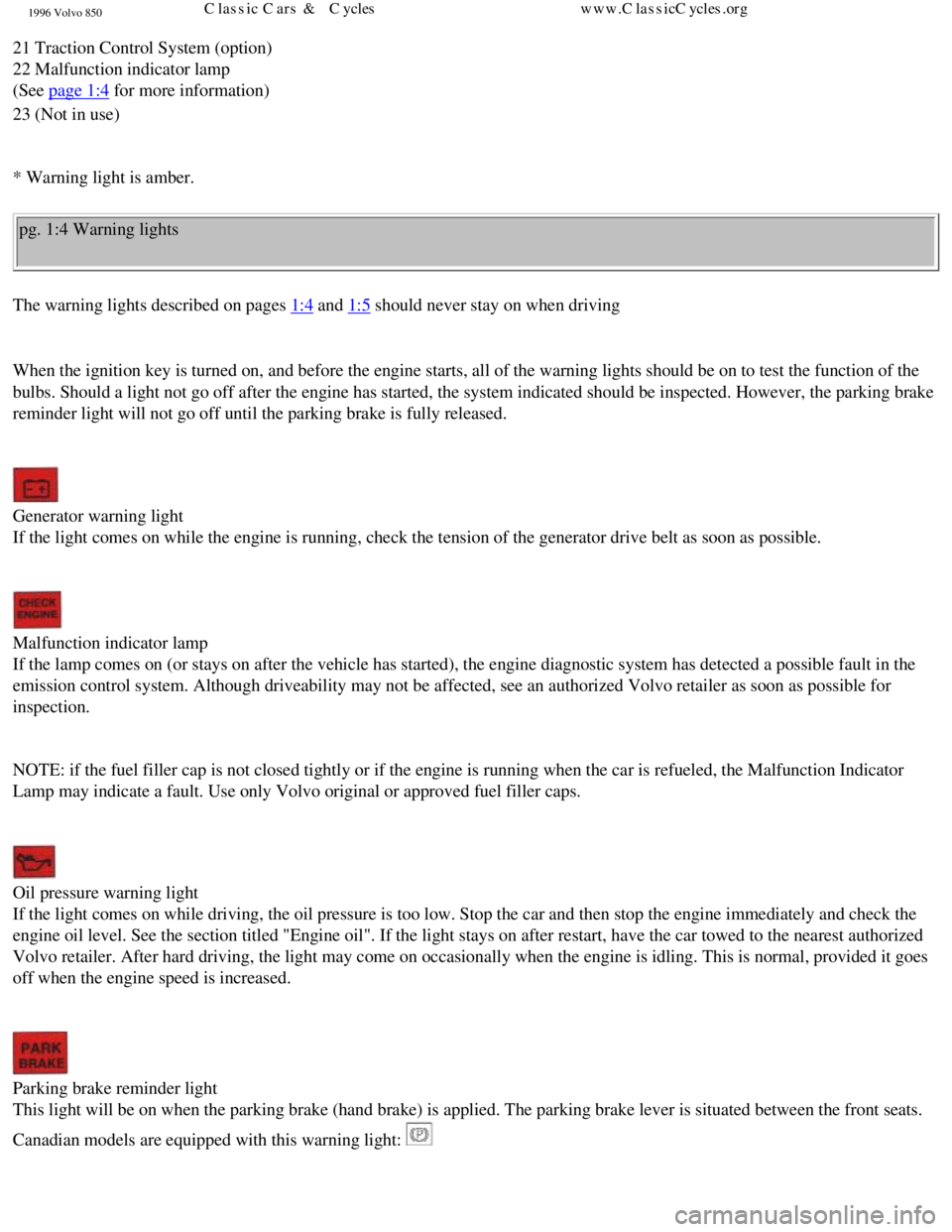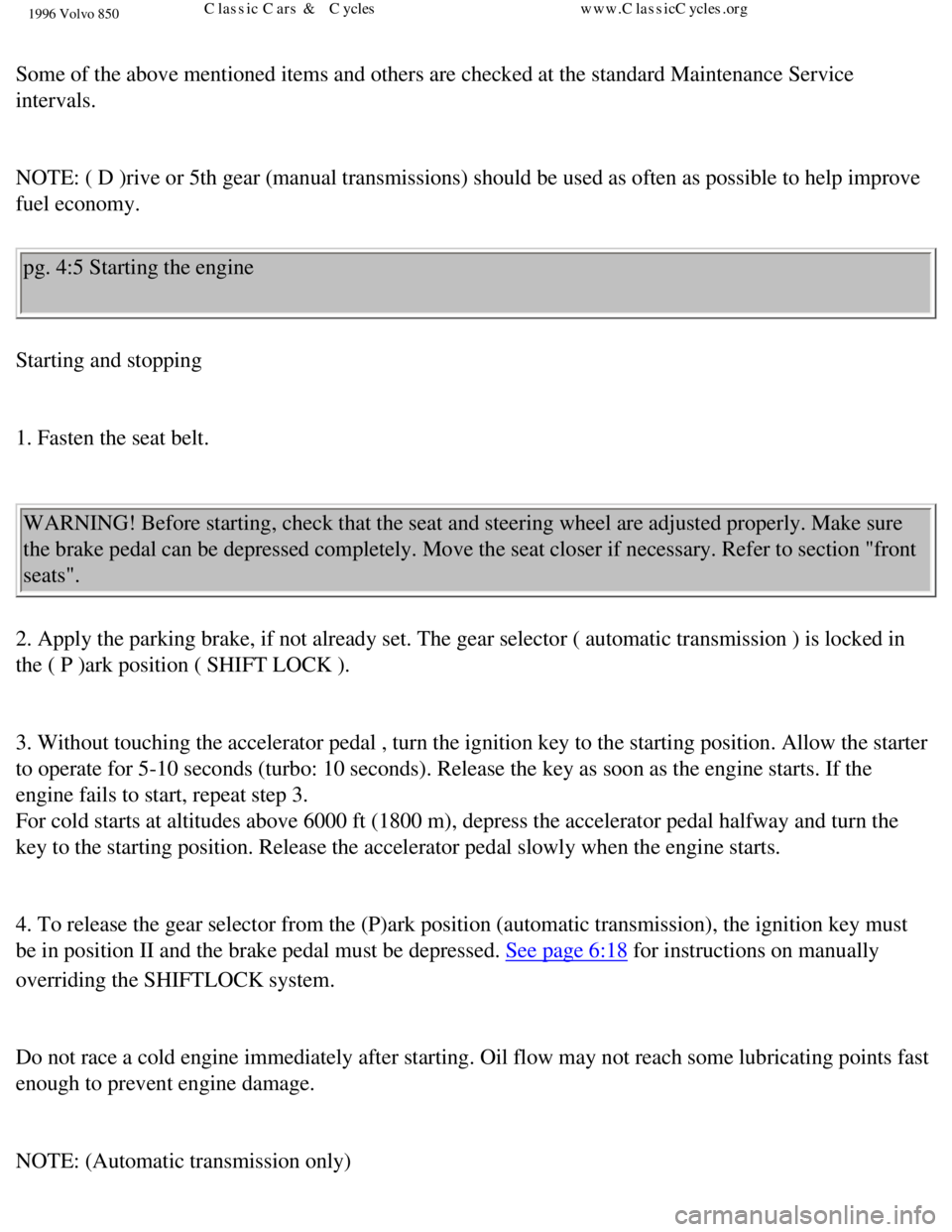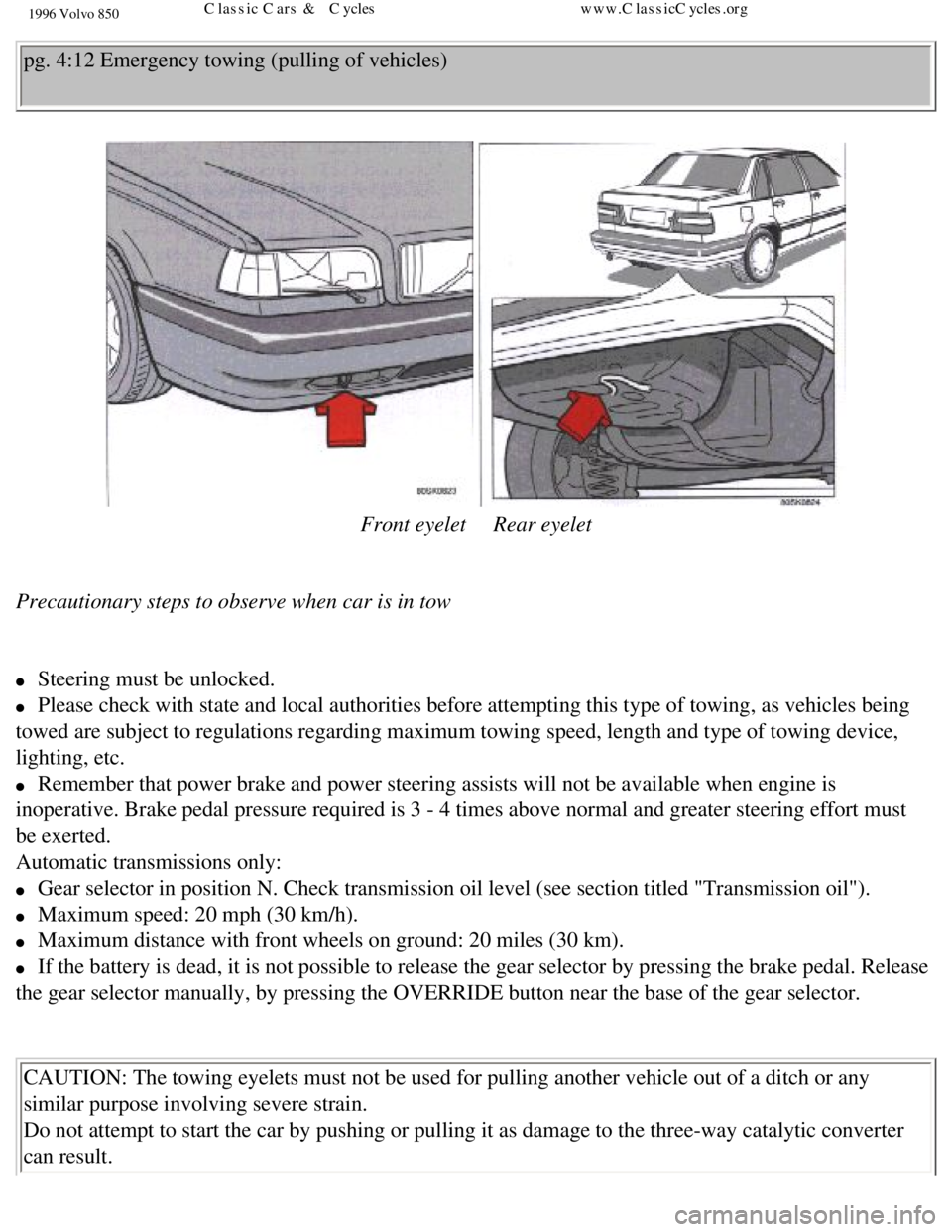engine oil VOLVO 850 1996 Owners Manual
[x] Cancel search | Manufacturer: VOLVO, Model Year: 1996, Model line: 850, Model: VOLVO 850 1996Pages: 265, PDF Size: 4.57 MB
Page 6 of 265

1996 Volvo 850
Used for measuring shorter distances. The last digit indicates 1/10 mile\
/kilometer. A black number on a white background =
original speedometer. A red number on a white background = replacement s\
peedometer.
9 Tachometer
Reads thousands of engine rpm. Engine should not be operated in red rang\
e. The highest permitted constant engine speed is
6,300 rpm (turbo: 6,200 rpm, B 5252 S: 6,000 rpm). pg. 1:3 Indicator and warning lights
1 Turn signal, left
2 Turn signal , right
3 (Not in use)
4 Low washer fluid level
If the lamp glows continuously when the engine is running, there is only\
about 1/2 - 1 US qt. remaining in the washer fluid
reservoir.
5 Low fuel level
When the lamp glows, only about 1.8 US gals. (8 liters) of fuel remain\
6 Rear fog light
7 High beams
8 (Not in use)
9 Bulb failure warning sensor
10 (Not in use)
11 (Not in use)
12 SRS
13 Generator not charging
14 Low engine oil pressure
15 Brake warning light
16 Parking brake applied
17 ABS-system
18 Ambient temperature warning light* (certain models)
(see pp. 1:11 or 1:14 for more information)
19 Transmission mode "W", or gear positions 3 or L engaged (automatic t\
ransmissions)
20 Low coolant level
file:///K|/ownersdocs/1996/1996_850/96850_101.htm (4 of 7)12/30/2006 9\
:58:55 AMClassic Cars & Cycles www.ClassicCycles.org
Page 7 of 265

1996 Volvo 850
21 Traction Control System (option)
22 Malfunction indicator lamp
(See
page 1:4 for more information)
23 (Not in use)
* Warning light is amber.
pg. 1:4 Warning lights
The warning lights described on pages
1:4 and 1:5 should never stay on when driving
When the ignition key is turned on, and before the engine starts, all of\
the warning lights should be on to test the function of the
bulbs. Should a light not go off after the engine has started, the syste\
m indicated should be inspected. However, the parking brake
reminder light will not go off until the parking brake is fully released\
.
Generator warning light
If the light comes on while the engine is running, check the tension of \
the generator drive belt as soon as possible.
Malfunction indicator lamp
If the lamp comes on (or stays on after the vehicle has started), the \
engine diagnostic system has detected a possible fault in the
emission control system. Although driveability may not be affected, see \
an authorized Volvo retailer as soon as possible for
inspection.
NOTE: if the fuel filler cap is not closed tightly or if the engine is r\
unning when the car is refueled, the Malfunction Indicator
Lamp may indicate a fault. Use only Volvo original or approved fuel fill\
er caps.
Oil pressure warning light
If the light comes on while driving, the oil pressure is too low. Stop t\
he car and then stop the engine immediately and check the
engine oil level. See the section titled "Engine oil". If the light stay\
s on after restart, have the car towed to the nearest authorized
Volvo retailer. After hard driving, the light may come on occasionally w\
hen the engine is idling. This is normal, provided it goes
off when the engine speed is increased.
Parking brake reminder light
This light will be on when the parking brake (hand brake) is applied. \
The parking brake lever is situated between the front seats.
Canadian models are equipped with this warning light:
file:///K|/ownersdocs/1996/1996_850/96850_101.htm (5 of 7)12/30/2006 9\
:58:55 AMClassic Cars & Cycles www.ClassicCycles.org
Page 137 of 265

1996 Volvo 850
l Move the seat as far forward as possible
WARNING! Cover sharp edges on load to help prevent injury to occupants. \
Secure load to help
prevent shifting during sudden stops.
Long load storage (sedans)
There is a flap located in the panel behind the rear seat which makes it\
possible to carry long loads such
as skis, etc. To open, pull the strap forward.
Protective covers (for skis) should be used to avoid soiling or tearin\
g the upholstery. Please note that the
flap in the rear seat is only intended for light loads such as skis, car\
pets, etc.
Max length: 6 1/2 ft (2 meters) Max weight: 55 lbs (25 kg)
WARNING! Always turn engine off and apply parking brake when loading/unl\
oading the vehicle.
Place transmission selector in P (PARK) position to help prevent inadv\
ertent movement of selector.
Contents | Top of Page
file:///K|/ownersdocs/1996/1996_850/96850_218.htm (7 of 7)12/30/2006 9\
:59:25 AMClassic Cars & Cycles www.ClassicCycles.org
Page 160 of 265

1996 Volvo 850
NOTE - ENGINE OIL:
Although some oil consumption during normal engine operation, more oil i\
s consumed when the engine
is new as the internal parts generate higher friction while wearing-in t\
o each other. From the time the
engine is new until the first service is performed, the oil consumption \
could be higher than normal. For
this reason, it is especially important to check the oil every time you \
refuel your car during this period.
See page 8:10.
In general, the rate of oil consumption depends on such factors as: engi\
ne temperature, length of trip,
driving conditions, oil viscosity and quality, engine speed and accelera\
tion/deceleration.
Checking your engine oil level each time the car is refuelled is one of \
the most important items you can
perform to help keep your car in good running order.
Manual transmission
The following speeds should not be exceeded during the break-in period: \
Up to 600 miles
(1000 km) 600 - 1,200 miles
(1000 - 2000 km)
1st gear 20 mph (30 km/h) 25 mph (40 km/h)
2nd gear 30 mph (50 km/h) 40 mph (70 km/h)
3rd gear 45 mph (80 km/h) 65 mph (100 km/
h)
4th gear 70 mph (110 km/
h) 80 mph (130 km/
h)
5th gear/
overdrive 80 mph (130 km/
h) 95 mph (150 km/
h)
Posted speed limits should not be exceeded.
file:///K|/ownersdocs/1996/1996_850/96850_401.htm (2 of 8)12/30/2006 9\
:59:32 AMClassic Cars & Cycles www.ClassicCycles.org
Page 163 of 265

1996 Volvo 850
CAUTION: Take care not to spill gasoline during refueling. Gasolines con\
taining alcohol can cause
damage to painted surfaces, which may not be covered under the New Vehic\
le Limited Warranty.
Do not use gasoline containing methanol (methyl alcohol, wood alcohol)\
. This practice can result in
vehicle performance deterioration and can damage critical parts in the f\
uel system. Such damage may
not be covered under the New Vehicle Limited Warranty.
pg. 4:4 Driving economy
Economical driving does not necessarily mean driving slowly
Better driving economy may be obtained by thinking ahead, avoiding rapid\
starts and stops and
adjusting the speed of your vehicle to immediate traffic conditions. Obs\
erve the following rules:
l Bring the engine to normal operating temperature as soon as possible by \
driving with a light foot on
the accelerator pedal for the first minutes of operation. A cold engine \
uses more fuel and is subject to
increased wear.
l Whenever possible, avoid using the car for driving short distances. This\
does not allow the engine to
reach normal operating temperature.
l Drive carefully and avoid rapid acceleration and hard braking.
l Do not exceed speed limit.
l Avoid carrying unnecessary items (extra load) in the car.
l Check tire pressure regularly (check when tires are cold).
l Remove snow tires when threat of snow or ice has ended.
l Note that roof racks, ski racks, etc., increase air resistance and there\
by fuel consumption.
l Avoid using automatic transmission kick-down feature unless necessary.
l Avoid using the air conditioning when it is not required. When engaged, \
the air conditioner's
compressor places places an additional load on the engine.
l If your car is equipped with the optional Trip Computer, utilizing the f\
uel consumption modes can
help you "learn" how to drive more economically.
Other factors which decrease gas mileage are:
l Low tire pressure
l Worn or dirty spark plugs
l Incorrect spark plug gap
l Dirty air cleaner
l Dirty engine oil and clogged oil filter
l Dragging brakes
l Incorrect front end alignment
file:///K|/ownersdocs/1996/1996_850/96850_401.htm (5 of 8)12/30/2006 9\
:59:32 AMClassic Cars & Cycles www.ClassicCycles.org
Page 164 of 265

1996 Volvo 850
Some of the above mentioned items and others are checked at the standard\
Maintenance Service
intervals.
NOTE: ( D )rive or 5th gear (manual transmissions) should be used as\
often as possible to help improve
fuel economy. pg. 4:5 Starting the engine
Starting and stopping
1. Fasten the seat belt.
WARNING! Before starting, check that the seat and steering wheel are adj\
usted properly. Make sure
the brake pedal can be depressed completely. Move the seat closer if nec\
essary. Refer to section "front
seats".
2. Apply the parking brake, if not already set. The gear selector ( aut\
omatic transmission ) is locked in
the ( P )ark position ( SHIFT LOCK ).
3. Without touching the accelerator pedal , turn the ignition key to the\
starting position. Allow the starter
to operate for 5-10 seconds (turbo: 10 seconds). Release the key as so\
on as the engine starts. If the
engine fails to start, repeat step 3.
For cold starts at altitudes above 6000 ft (1800 m), depress the accel\
erator pedal halfway and turn the
key to the starting position. Release the accelerator pedal slowly when \
the engine starts.
4. To release the gear selector from the (P)ark position (automatic t\
ransmission), the ignition key must
be in position II and the brake pedal must be depressed.
See page 6:18 for instructions on manually
overriding the SHIFTLOCK system.
Do not race a cold engine immediately after starting. Oil flow may not r\
each some lubricating points fast
enough to prevent engine damage.
NOTE: (Automatic transmission only)
file:///K|/ownersdocs/1996/1996_850/96850_401.htm (6 of 8)12/30/2006 9\
:59:32 AMClassic Cars & Cycles www.ClassicCycles.org
Page 165 of 265

1996 Volvo 850
Your car is equipped with a KEYLOCK system. When the engine is switched \
off, the gear selector must
be in the ( P )ark position before the starting key can be removed fro\
m the ignition switch.
5. Select desired gear. The gear engages after a slight delay (automati\
c transmission) which is especially
noticeable when selecting R.
CAUTION: (Automatic transmission only) The engine should be idling; ne\
ver accelerate until after
you feel the gear engage! Too rapid acceleration immediately after selec\
ting a gear will cause harsh
engagement and premature transmission wear.
NOTE: Selecting P or N (automatic transmission) when idling at a stand\
still for prolonged periods of
time will help prevent overheating of transmission oil.
WARNING! Always place the gear selector (automatic transmission) in Pa\
rk and apply the parking
brake before leaving the vehicle. Never leave the car unattended with th\
e engine running.
Always open the garage doors fully before starting the engine inside a g\
arage to ensure adequate
ventilation. The exhaust gases contain carbon monoxide, which is invisib\
le and odorless but very
poisonous.
TURBO CAUTION:
Never race the engine immediately after starting. Oil flow may not reach\
some lubricating points fast
enough to prevent engine damage.
Do not race the engine just prior to switching off!
Hydraulic valve lifters
This engine features hydraulic valve lifters which means that valve clea\
rance is adjusted automatically.
It is possible that the valve lifters will produce a ticking sound for t\
he first few seconds after the engine
is started, while the oil pressure is increasing.
If the car has not been used for a long period of time, this ticking sou\
nd may last for up to 15 minutes.
This is entirely normal.
Do not exceed 300 rpm until the ticking sound disappears.
file:///K|/ownersdocs/1996/1996_850/96850_401.htm (7 of 8)12/30/2006 9\
:59:32 AMClassic Cars & Cycles www.ClassicCycles.org
Page 173 of 265

1996 Volvo 850
pg. 4:9 Automatic transmission
Special Tips - automatic transmission
l For driving down steep hills and when driving for prolonged periods at l\
ow speeds, position L should
be selected. Avoid, however, repeated changes since this can cause overh\
eating of the transmission oil.
For driving on long continuous uphill gradients, select position 3.
l See caution on page 4:7.
l Do not hold the car stationary on an incline by using the accelerator pe\
dal. Instead, apply the hand
brake (parking brake). This prevents the transmission oil from becomin\
g overheated.
l When towing a trailer, select shift position 3.
l The (E)conomy mode should be selected when the cruise control is engag\
ed.
l While towing a trailer in hilly terrain, do not drive continuously at en\
gine speeds above 4500 rpm to
help avoid high engine oil temperatures.
pg. 4:10 Points to remember
Cooling system
The risk for engine overheating is greatest, especially in hot weather, \
when:
l towing a trailer up steep inclines for prolonged periods at wide open th\
rottle and low engine rpm.
l stopping the engine suddenly after high speed driving (so-called "after\
-boiling" can occur).
l To avoid overheating, the following rules should be followed:
l Do not drive for prolonged periods at engine speeds above 4500 rpm if yo\
u are towing a trailer in
hilly terrain.
l Reduce speed and downshift when towing a trailer up long, steep inclines\
. The risk of overheating can
be reduced by switching off the air conditioning system for a short time\
.
l Do not let the engine idle unnecessarily for prolonged periods.
l Do not mount auxiliary lamps in front of the grill.
When the risk of overheating is imminent, or in the event of overheating\
, (the temperature gauge goes
repeatedly into, or stays continually in, the red section) the followin\
g precautions should be taken:
l Switch off the air conditioning system.
l Stop the car and put the gear lever into neutral. Do not stop the engine\
!
l Switch the heater to full (maximum) position. Increase the engine spee\
d to approx. 2000 rpm (twice
idling speed) until the temperature begins to drop.
file:///K|/ownersdocs/1996/1996_850/96850_406.htm (7 of 10)12/30/2006 \
9:59:34 AMClassic Cars & Cycles www.ClassicCycles.org
Page 177 of 265

1996 Volvo 850
pg. 4:12 Emergency towing (pulling of vehicles)
Front eyelet Rear eyelet
Precautionary steps to observe when car is in tow
l Steering must be unlocked.
l Please check with state and local authorities before attempting this typ\
e of towing, as vehicles being
towed are subject to regulations regarding maximum towing speed, length \
and type of towing device,
lighting, etc.
l Remember that power brake and power steering assists will not be availab\
le when engine is
inoperative. Brake pedal pressure required is 3 - 4 times above normal a\
nd greater steering effort must
be exerted.
Automatic transmissions only:
l Gear selector in position N. Check transmission oil level (see section \
titled "Transmission oil").
l Maximum speed: 20 mph (30 km/h).
l Maximum distance with front wheels on ground: 20 miles (30 km).
l If the battery is dead, it is not possible to release the gear selector \
by pressing the brake pedal. Release
the gear selector manually, by pressing the OVERRIDE button near the bas\
e of the gear selector.
CAUTION: The towing eyelets must not be used for pulling another vehicle\
out of a ditch or any
similar purpose involving severe strain.
Do not attempt to start the car by pushing or pulling it as damage to th\
e three-way catalytic converter
can result.
file:///K|/ownersdocs/1996/1996_850/96850_412.htm (1 of 10)12/30/2006 \
9:59:35 AMClassic Cars & Cycles www.ClassicCycles.org
Page 183 of 265

1996 Volvo 850
pg. 4:17 Trailer towing
When preparing for trailer towing, observe the following:
l Volvo recommends the use of Volvo trailer hitches which are specially de\
signed for the car. For
trailer weights exceeding 2000 lbs. (908 kg), use only a trailer hitch\
offered as a Genuine Volvo
accessory.
NOTE: Models with automatic transmission are equipped with a transmissio\
n oil cooler as standard
equipment. This cooler helps prevent overheating of the transmission dur\
ing times of increased load, as
when towing a trailer.
l Maximum trailer weight recommended by Volvo is:
Trailers without brakes : 1100 lbs (500kg)
Trailers with brakes: 2" (50 mm) ball - 3300 lbs (1500 kg), 1 7/8" (\
47 mm) ball - 2000 lbs (908 kg).
Observe the legal requirements of the state/province in which the vehicl\
es are registered. All Volvo
models are equipped with energy-absorbing shock-mounted bumpers. Trailer\
hitch installation should
not interfere with the proper operation of this bumper system.
Trailer towing does not normally present any particular problems, but ta\
ke into consideration:
l Increase tire pressure to recommended full. See section "Wheels and tire\
s".
l Recommended hitch tongue load is 110 (50 kgs) for trailer weights belo\
w 2,650 lbs (1,200 kgs) and
165 lbs (75 kgs) for trailer weights above 2,650 lbs (1,200 kgs). Fo\
r trailer weights between 2,650-3,300
lbs (1,200-1,500 kgs) a top speed of 50 mph (80 km/h) should never b\
e exceeded.
l Engine and transmission are subject to increased loads. Therefore, engin\
e coolant temperature should
be closely watched when driving in hot climates or hilly terrain. Use lo\
wer gear and turn off air
conditioner if temperature gauge pointer enters the red range.
l Avoid overload and other abusive operation.
l Hauling a trailer affects handling, durability, and economy.
l It is necessary to balance trailer brakes with the towing vehicle brakes\
to provide a safe stop (check
and observe State/Local regulations).
l Do not connect the trailer's brake system directly to the vehicle's brak\
e system.
l More frequent vehicle maintenance is required.
l Remove the ball and drawbar assembly when the hitch is not being used.
l Volvo recommends the use of synthetic engine oil when towing a trailer o\
ver long distances or in
file:///K|/ownersdocs/1996/1996_850/96850_412.htm (7 of 10)12/30/2006 \
9:59:35 AMClassic Cars & Cycles www.ClassicCycles.org